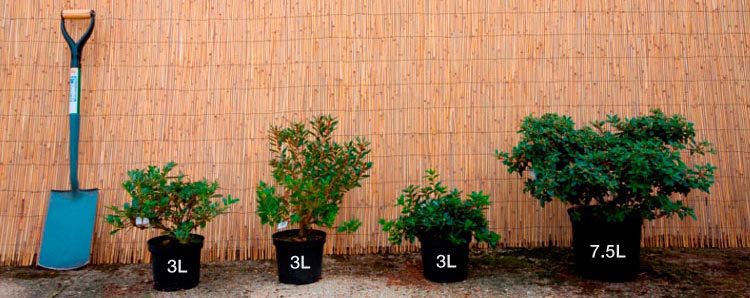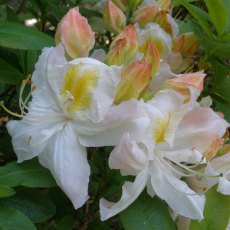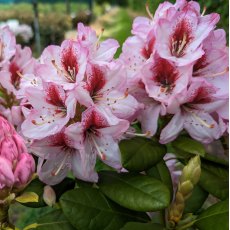Magnolia x loebneri 'Leonard Messel' AGM
Item: MLEON
 Currently Unavailable
Currently Unavailable
April
Dark Pink
200-400cm
Not Scented
No
To -15 °C
Collect in Store
This item is available for collection.
Home Delivery
UK mainland delivery from £8.95
Lovely lilac buds open to beautiful star-like flowers with a pink flush. This is a very free flowering plant in April that makes a magnificent shrub or small tree. The flowers emerge before the foliage. An extremely popular shrub for the smaller garden that will perform best in full sun, and will tolerate any reasonable soil except waterlogged.
Magnolia kobus was hybridised with M.stellata by Max Loebner prior to 1914 to produce the Magnolia x loebneri cultivar. Diverse habits resulted and this is one of the better clones raised by James Comber, the head gardener to the Countess of Rosse at Nymans gardens in the 1950’s. The flower colour can vary significantly depending upon winter temperatures. Flowers will be deeper pink in mild locations, but almost white after a cold winter.
- Recommended for smaller gardens and its frost-resistant flowers.
- Easy to grow.
- Ideal position: Most garden situations, will flower in dappled shade but prefers full sun.
- Habit: Shrub/small tree.
- Group: Magnolia x loebneri.
- Parentage: clone of Magnolia kobus x M. stellata.
- Hybridization date: pre 2000 (1955).
- Bred by: James Comber of Nymans Garden. Origin: British.
- Ideal soil: generally pH 5.5 to 6.5 but this variety will tolerate most soil conditions except waterlogging.
- RHS Hardiness Rating: H6.
- How we usually propagate this plant: Cutting.
- Awards: RHS Award of Garden Merit.
Customer Reviews





Good to know
Magnolia
Magnolias consist of deciduous and evergreen large shrubs or feature size trees, many with nicely scented flowers in spring and summer. They provide great structure in the garden, as well as stunning flowers in shades of white, pink and purple in early spring, followed by the yellow flowering varieties which tend to be a little later, and can avoid spring frosts.
We have an excellent modern range including the latest varieties from top breeders around the world. Being new and grafted, they cost a bit more than the more common varieties. Due to delivery constraints, we are only able to send young plants, but these establish much better than mature stock anyway.
Magnolias prefer full sun, cool roots and shelter from strong winds. They are not suitable for growing in patio pots, which they will quickly outgrow. Plant in free draining, moisture retentive neutral to slightly acidic soil, deeply worked with added ericaceous compost. After planting, feed with a good ericaceous fertilizer and mulch well. Apply slow-release fertilizer every spring whilst the plant is establishing, at the rate of a teaspoon per 3 litre plant, rising to a handful for a more mature plant. Most stellata hybrids will flower from the 4 litre size, and soulangeana hybrids will typically flower once they reach about 2 metres high. Be aware that some magnolias (eg campbelli) can take up to 40 years to flower when grown from seed.
Young plants can be trained into a bush or a tree shape when young. Select a strong shoot to tie against a cane if you want a plant with a straight stem. Magnolias should only be pruned lightly, and only during the summer months of June to September. Prune any weak growth or small branches that cross over each other or spoil the shape. Severe pruning can be stressful and induce the formation of strong vertical ‘watershoots’, so renovation work is best carried out over several years to avoid pruning too much at any one time.
Magnolias were amongst the first plants on Earth to reproduce using flowers pollinated by insects. They are native to America and Asia, but not Europe. The Magnolia was named by Linnaeus in commemoration of Pierre Magnol, who was Louis XIV's doctor and a professor of Botany. Magnolia grandiflora was introduced into Britain from America in 1734. The first magnolias from China arrived around 1780, and proved much hardier than those from America.
Please note: Deer like to rub their antlers on the stems, so a 1 metre high ring of netting protection may be necessary for a few years if deer have access to your garden.
The Basics
Ideal soil
Acidic soil, good organic content, pH 4.5-6.0. Inkarho range of rhododendrons will tolerate soils up to pH7.5
Sun or Shade
Light dappled shade is best for most varieties.
Shelter
Refer to hardiness rating. Give young plants protection.
Site Selection
Avoid close to trees, roots, invasive weeds, walls, hot patios, dry banks and waterlogged soils. Do not use weed matting or stone mulch.
Plant spacing
Use the height shown in 10 years as a guide to the distance between each plant. Allow room for plant to fill out. If planting closer for instant impact, be prepared to move plants after a few years.
Compost
- 3 litre pot, dig in 10-20 litres of ericaceous compost.
- 7.5 litre pot, dig in 20-30 litres of ericaceous compost.
- 70-80cm specimen, dig in 60 litres of ericaceous compost.
- 100-120cm specimen, dig in 120 litres of ericaceous compost.
Planting depth
Plant high in the ground, with the top of the rootball visible.
Feeding
Slow-release ericaceous feed recommended in March and straight after flowering.
Mulch
Recommended every few years.
Water
The key ingredient! Keep moist all season, especially the critical time at end of June for flower bud initiation. Tap water is better than no water. Heavy dose at least once per week in dry weather.
Drainage
Ensure good drainage in winter, especially with yellow flowering varieties. Avoid waterlogged sites.
Pruning
Rhododendrons and Camellias: Not normally required. Tidy wayward shoots after flowering.
Evergreen azaleas and Bloombux can be clipped into a low hedge.
Magnolias and Acers: Formative pruning when young to shape into a tree or bush.
Deadheading
Remove old flower-heads, particularly on young or weak plants.
For further advice see here
Size Guide

Delivery & Returns
Our website calculates the delivery charge according to weight and delivery location throughout the UK. To see these charges, please enter your postcode at the checkout, and you will see the charge vary as you add more items to your wheelbarrow.
 Millais Nurseries
Millais Nurseries














